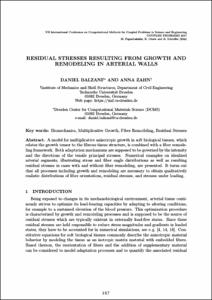Mostra el registre d'ítem simple
Residual stresses resulting from growth and remodeling in arterial walls
| dc.contributor.author | Balzani, Daniel |
| dc.contributor.author | Zahn, Anna |
| dc.date.accessioned | 2020-06-09T09:31:22Z |
| dc.date.available | 2020-06-09T09:31:22Z |
| dc.date.issued | 2017 |
| dc.identifier.isbn | 978-84-946909-2-1 |
| dc.identifier.uri | http://hdl.handle.net/2117/190290 |
| dc.description.abstract | A model for multiplicative anisotropic growth in soft biological tissues, which relates the growth tensor to the fibrous tissue structure, is combined with a fiber remode- ling framework. Both adaptation mechanisms are supposed to be governed by the intensity and the directions of the tensile principal stresses. Numerical examples on idealized arterial segments, illustrating stress and fiber angle distributions as well as resulting residual stresses in cases with and without fiber remodeling, are presented. It turns out that all processes including growth and remodeling are necessary to obtain qualitatively realistic distributions of fiber orientations, residual stresses, and stresses under loading. |
| dc.format.extent | 12 p. |
| dc.language.iso | eng |
| dc.publisher | CIMNE |
| dc.subject | Àrees temàtiques de la UPC::Matemàtiques i estadística::Anàlisi numèrica::Mètodes en elements finits |
| dc.subject.lcsh | Finite element method |
| dc.subject.lcsh | Coupled problems (Complex systems) -- Numerical solutions |
| dc.subject.other | Biomechanics, Multiplicative Growth, Fiber Remodeling, Residual Stresses |
| dc.title | Residual stresses resulting from growth and remodeling in arterial walls |
| dc.type | Conference report |
| dc.subject.lemac | Elements finits, Mètode dels |
| dc.rights.access | Open Access |
| local.citation.contributor | COUPLED VII |
| local.citation.startingPage | 167 |
| local.citation.endingPage | 178 |


